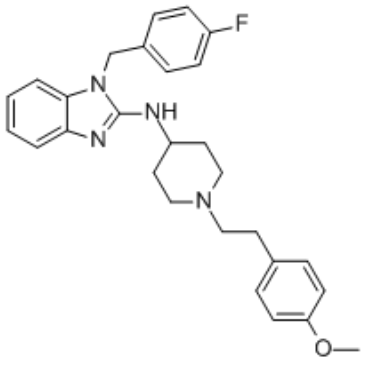

阿司咪唑结构式

|
常用名 | 阿司咪唑 | 英文名 | Astemizole |
|---|---|---|---|---|
| CAS号 | 68844-77-9 | 分子量 | 458.57 | |
| 密度 | 1.2 g/cm3 | 沸点 | 627.3ºC at 760 mmHg | |
| 分子式 | C28H31FN4O | 熔点 | 172.9ºC | |
| MSDS | 中文版 美版 | 闪点 | 333.2ºC | |
| 符号 |

GHS07 |
信号词 | Warning |
|
Antihistamines modulate the integrin signaling pathway in h9c2 rat cardiomyocytes: Possible association with cardiotoxicity.
Hum. Exp. Toxicol. 34 , 796-807, (2015) The identification of biomarkers for toxicity prediction is crucial for drug development and safety evaluation. The selective and specific biomarkers for antihistamines-induced cardiotoxicity is not well identified yet. In order to evaluate the mechanism of t... |
|
|
Tuning of EAG K(+) channel inactivation: molecular determinants of amplification by mutations and a small molecule.
J. Gen. Physiol. 140(3) , 307-24, (2012) Ether-à-go-go (EAG) and EAG-related gene (ERG) K(+) channels are close homologues but differ markedly in their gating properties. ERG1 channels are characterized by rapid and extensive C-type inactivation, whereas mammalian EAG1 channels were previously consi... |
|
|
Astemizole: a long-acting, nonsedating antihistamine.
Drug Intell. Clin. Pharm. 21(12) , 947-53, (1987) Astemizole is a long-acting, highly selective histamine1-receptor antagonist with minimal central and anticholinergic effects. Comparison studies have shown astemizole to be equal or superior to currently available antihistamines, beclomethasone nasal spray, ... |
|
|
[Astemizole: its pharmacokinetics and pharmacologic properties].
Allerg. Immunol. (Paris.) 22(6) , 233-41, (1990) Astemizole (Hismanal) is a chemically novel compound selected from a series of piperidinylaminobenzimidazoles. Further preclinical pharmacological investigations were initiated by experiences with other drugs in the same field. The aim of this review is to il... |
|
|
The possible involvement of hyperpolarizing mechanisms in histamine-induced relaxation of the rat portal vein.
J. Smooth Muscle Res. 44(3-4) , 129-41, (2008) The present study evaluated the effects of histamine 10(-2) M on longitudinal preparations of rat portal vein. It was observed that histamine 10(-2) M induced relaxation of rat portal vein preparations pre-contracted with phenylephrine 10(-4) M. On the other ... |
|
|
[Efficacy and safety of astemizole in the treatment of allergic rhinitis and urticaria: a systematic review with meta-analysis].
Rev. Alerg. Mex. 52(3) , 113-26, (2005) To compare astemizole with other first or second generation antihistaminics in the treatment of allergic rhinitis or urticaria.Systematic revision of clinical, controlled and randomized tests.36 controlled, randomized, clinical, double or simple blind tests w... |
|
|
Astemizole. A review of its pharmacodynamic properties and therapeutic efficacy.
Drugs 28(1) , 38-61, (1984) Astemizole is an H1-histamine receptor antagonist with a long duration of action permitting once daily administration. Its efficacy in seasonal and perennial allergic rhinitis has been convincingly demonstrated, and several comparative studies suggest that as... |
|
|
Unique drug screening approach for prion diseases identifies tacrolimus and astemizole as antiprion agents.
Proc. Natl. Acad. Sci. U. S. A. 110(17) , 7044-9, (2013) Prion diseases such as Creutzfeldt-Jakob disease (CJD) are incurable and rapidly fatal neurodegenerative diseases. Because prion protein (PrP) is necessary for prion replication but dispensable for the host, we developed the PrP-FRET-enabled high throughput a... |
|
|
Torsades de pointes ventricular tachycardia associated with overdose of astemizole.
Mayo Clin. Proc. 69(6) , 589-93, (1994) An overdose of astemizole predisposes the myocardium to ventricular dysrhythmias, including torsades de pointes. Herein we describe a case of astemizole-induced torsades de pointes ventricular tachycardia and also review previous case reports in the literatur... |
|
|
Astemizole and an analogue promote fungicidal activity of fluconazole against Cryptococcus neoformans var. grubii and Cryptococcus gattii.
Med. Mycol 48(2) , 255-62, (2010) Cryptococcus neoformans is the leading cause of fungal meningitis, a life-threatening infection that occurs predominately in immuocompromised patients. Current drug therapies are limited to amphotericin B, flucytosine and the azoles since the echinocandins ha... |